#Ballymurphy Massacre
Text
#OTD in Irish History | 11 August:
In the Liturgical Calendar it is the Feast Day of Saint Attracta (also called Araght, and Naomh Adhracht in Irish), the patron saint of the parish of Tourlestrane, Co Sligo. Her legend states that she fled from home and took her vows as a nun under St Patrick at Coolavin. She then moved to Lough Gara, where she founded a hostel for travellers at a place now called Killaraght in her honour. The…

View On WordPress
#irelandinspires#irishhistory#OTD#11 August#anti-Treaty#Éamon De Valera#Ballymurphy Massacre#Co. Clare#Dan Breen#Dáil Eireann#Doolin#Feast Day of Saint Attracta#Free State#George Karbus Photography#History#History of Ireland#IRA#Ireland#Irish Civil War#Irish History#Liam Lynch#Limerick#Patrick Sarsfield#RUC#Today in Irish History
11 notes
·
View notes
Text

Reminder that the British are still trying to cover up the war crimes they commited in Northern Ireland to stop people getting justice for their family members that were shot dead. So many civilians were shot dead and the military protected the culprits. The soldiers involved in Bloody Sunday are free. The soldiers involved in the Ballymurphy Massacre are free too. The government covered it up for years and claimed the victims were terrorists and now that they're finally trying to get justice the state is covering for them again. British soldiers got away with murder in this country and need to be held accountantable.
Fuck the British Army and fuck anyone that supports them.
46 notes
·
View notes
Text
Take a look at this post… 'Report Finding: British Government's legacy bill is in breach of the Good Friday Agreement'.
Take a look at this post… ‘Report Finding: British Government’s legacy bill is in breach of the Good Friday Agreement’.
http://seachranaidhe-irishandproud.blogspot.com/2022/05/report-finding-british-governments.html
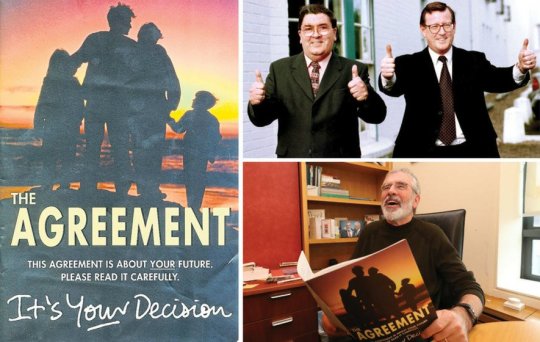
View On WordPress
#Ballymurphy Massacre#Bloody Sunday#CAJ#Committee on the Administration of Justice#In breach of the Good Friday Agreement#Legacy Bill#Never Trust A Tory#NI Secretary of State Brandon Lewis#QUB#Tory Lies
0 notes
Text
i don't even like sinn féin that much but the handwringing from thatcherites over their electoral success is really too much to bear
"look at me im a british journalist, i think the ira were bad but that government collusion with murderers like the shankill butchers was an unfortunate consequence of intelligence work 😞"
#there is literally mountains of evidence of state collusion with loyalist paramilitaries#the miami showband massacre. the dublin monaghan bombings. the loughinisland massacre etc. etc.#nvm the times that the army just shot people outright like bloody sunday and the ballymurphy massacre
42 notes
·
View notes
Text
Just leaving this here.
52 years ago today.
Please kindly reblog the shit out of this.
#personal stuff#dougie rambles#political crap#history#irish history#ireland#irish republicanism#fuck loyalism
98 notes
·
View notes
Text
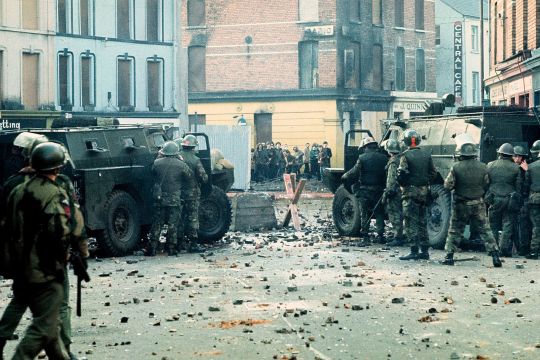
30 January 1972: Bogside Massacre, or the Bloody Sunday
Bogside Massacre, or the Bloody Sunday, was a massacre on 30 January 1972 in the Bogside area of Derry, Northern Ireland, when British soldiers shot 26 civilians during a protest march against internment without trial. Fourteen people died: 13 were killed outright, while the death of another man four months later was attributed to his injuries. Many of the victims were shot while fleeing from the soldiers, and some were shot while trying to help the wounded. Other protesters were injured by shrapnel, rubber bullets, or batons, and two were run down by army vehicles. All of those shot were Catholics. The march had been organised by the Northern Ireland Civil Rights Association (NICRA). The soldiers were from the 1st Battalion, Parachute Regiment (“1 Para”), the same regiment implicated in the Ballymurphy massacre several months prior.
Two investigations were held by the British government. The Widgery Tribunal, held in the immediate aftermath, largely cleared the soldiers and British authorities of blame. It described the soldiers’ shooting as “bordering on the reckless”, but accepted their claims that they shot at gunmen and bomb-throwers. The report was widely criticised as a “whitewash”. The Saville Inquiry, chaired by Lord Saville of Newdigate, was established in 1998 to reinvestigate the incident. Following a 12-year investigation, Saville’s report was made public in 2010 and concluded that the killings were both “unjustified” and “unjustifiable”. It found that all of those shot were unarmed, that none were posing a serious threat, that no bombs were thrown and that soldiers “knowingly put forward false accounts” to justify their firing. The soldiers denied shooting the named victims but also denied shooting anyone by mistake. On publication of the report, the British prime minister David Cameron made a formal apology on behalf of the United Kingdom. Following this, police began a murder investigation into the killings.
Bloody Sunday came to be regarded as one of the most significant events of the Troubles, because many civilians were killed by forces of the state, in full view of the public and the press. It was the highest number of people killed in a single shooting incident during the conflict and is considered the worst mass shooting in Northern Irish history. Bloody Sunday fuelled Catholic and Irish nationalist hostility towards the British Army and worsened the conflict. Support for the Provisional Irish Republican Army (IRA) rose, and there was a surge of recruitment into the organisation, especially locally.
In all, 26 people were shot by the paratroopers; 13 died on the day and another died of his injuries four months later. The dead were killed in four main areas: the rubble barricade across Rossville Street, the courtyard car park of Rossville Flats (on the north side of the flats), the courtyard car park of Glenfada Park, and the forecourt of Rossville Flats (on the south side of the flats).
All of the soldiers responsible insisted that they had shot at, and hit, gunmen or bomb-throwers. No soldier said he missed his target and hit someone else by mistake. The Saville Report concluded that all of those shot were unarmed and that none were posing a serious threat. It also concluded that none of the soldiers fired in response to attacks, or threatened attacks, by gunmen or bomb-throwers. No warnings were given before soldiers opened fire.
The casualties are listed in the order in which they were killed.
John ‘Jackie’ Duddy, age 17. Shot as he ran away from soldiers in the car park of Rossville Flats. The bullet struck him in the shoulder and entered his chest. Three witnesses said they saw a soldier take deliberate aim at the youth as he ran. He was the first fatality on Bloody Sunday. Both Saville and Widgery concluded that Duddy was unarmed.
Michael Kelly, age 17. Shot in the stomach while standing at the rubble barricade on Rossville Street. Both Saville and Widgery concluded that Kelly was unarmed. The Saville Inquiry concluded that 'Soldier F’ shot Kelly.
Hugh Gilmour, age 17. Shot as he ran away from soldiers near the rubble barricade. The bullet went through his left elbow and entered his chest. Widgery acknowledged that a photograph taken seconds after Gilmour was hit corroborated witness reports that he was unarmed. The Saville Inquiry concluded that 'Private U’ shot Gilmour.
William Nash, age 19. Shot in the chest at the rubble barricade. Three people were shot while apparently going to his aid, including his father Alexander Nash.
John Young, age 17. Shot in the face at the rubble barricade, apparently while crouching and going to the aid of William Nash.
Michael McDaid, age 20. Shot in the face at the rubble barricade, apparently while crouching and going to the aid of William Nash.
Kevin McElhinney, age 17. Shot from behind, near the rubble barricade, while attempting to crawl to safety.
James 'Jim’ Wray, age 22. Shot in the back while running away from soldiers in Glenfada Park courtyard. He was then shot again in the back as he lay mortally wounded on the ground. Witnesses, who were not called to the Widgery Tribunal, stated that Wray was calling out that he could not move his legs before he was shot the second time. 'Soldier F’ faces charges for his murder.
William McKinney, age 26. Shot in the back as he attempted to flee through Glenfada Park courtyard. 'Soldier F’ faces charges for his murder.
Gerard 'Gerry’ McKinney, age 35. Shot in the chest at Abbey Park. A soldier, identified as 'Private G’, ran through an alleyway from Glenfada Park and shot him from a few yards away. Witnesses said that when he saw the soldier, McKinney stopped and held up his arms, shouting “Don’t shoot! Don’t shoot!”, before being shot. The bullet apparently went through his body and struck Gerard Donaghy behind him.
Gerard 'Gerry’ Donaghy, age 17. Shot in the stomach at Abbey Park while standing behind Gerard McKinney. Both were apparently struck by the same bullet. Bystanders brought Donaghy to a nearby house. A doctor examined him, and his pockets were searched for identification. Two bystanders then attempted to drive Donaghy to hospital, but the car was stopped at an Army checkpoint. They were ordered to leave the car and a soldier drove the vehicle to a Regimental Aid Post, where an Army medical officer pronounced Donaghy dead. Shortly after, soldiers found four nail bombs in his pockets. The civilians who searched him, the soldier who drove him to the Army post, and the Army medical officer, all said that they did not see any bombs. This led to claims that soldiers planted the bombs on Donaghy to justify the killings.
Patrick Doherty, age 31. Shot from behind while attempting to crawl to safety in the forecourt of Rossville Flats. The Saville Inquiry concluded that he was shot by 'Soldier F’, who came out of Glenfada Park. Doherty was photographed, moments before and after he died, by French journalist Gilles Peress. Despite testimony from 'Soldier F’ that he had shot a man holding a pistol, Widgery acknowledged that the photographs show Doherty was unarmed, and that forensic tests on his hands for gunshot residue proved negative.
Bernard 'Barney’ McGuigan, age 41. Shot in the back of the head when he walked out from cover to help Patrick Doherty. He had been waving a white handkerchief to indicate his peaceful intentions. The Saville Inquiry concluded that he was shot by 'Soldier F’.
John Johnston, age 59. Shot in the leg and left shoulder on William Street 15 minutes before the rest of the shooting started. Johnston was not on the march, but on his way to visit a friend in Glenfada Park. He died on 16 June 1972; his death has been attributed to the injuries he received on the day. He was the only fatality not to die immediately or soon after being shot.
Paul McCartney (who is of Irish descent) recorded the first song in response only two days after the incident. The single, entitled “Give Ireland Back to the Irish”, expressed his views on the matter. This song was one of few McCartney released with Wings to be banned by the BBC.
The 1972 John Lennon album Some Time in New York City features a song entitled “Sunday Bloody Sunday”, inspired by the incident, as well as the song “The Luck of the Irish”, which dealt more with the Irish conflict in general. Lennon, who was of Irish descent, also spoke at a protest in New York in support of the victims and families of Bloody Sunday.
Irish poet Thomas Kinsella’s 1972 poem Butcher’s Dozen is a satirical and angry response to the Widgery Tribunal and the events of Bloody Sunday.
Black Sabbath’s Geezer Butler (also of Irish descent) wrote the lyrics to the Black Sabbath song “Sabbath Bloody Sabbath” on the album of the same name in 1973. Butler stated, “…the Sunday Bloody Sunday thing had just happened in Ireland, when the British troops opened fire on the Irish demonstrators… So I came up with the title 'Sabbath Bloody Sabbath’, and sort of put it in how the band was feeling at the time, getting away from management, mixed with the state Ireland was in.”
The Roy Harper song “All Ireland” from the album Lifemask, written in the days following the incident, is critical of the military but takes a long-term view with regard to a solution. In Harper’s book (The Passions of Great Fortune), his comment on the song ends “…there must always be some hope that the children of 'Bloody Sunday’, on both sides, can grow into some wisdom”.
Brian Friel’s 1973 play The Freedom of the City deals with the incident from the viewpoint of three civilians.
Irish poet Seamus Heaney’s Casualty (published in Field Work, 1981) criticizes Britain for the death of his friend.
The Irish rock band U2 commemorated the incident in their 1983 protest song “Sunday Bloody Sunday”.
Christy Moore’s song “Minds Locked Shut” on the album Graffiti Tongue is all about the events of the day, and names the dead civilians.
The events of the day have been dramatised in two 2002 television films, Bloody Sunday (starring James Nesbitt) and Sunday by Jimmy McGovern.
The Celtic metal band Cruachan addressed the incident in a song “Bloody Sunday” from their 2004 album Folk-Lore.
Willie Doherty, a Derry-born artist, has amassed a large body of work which addresses the troubles in Northern Ireland. “30 January 1972” deals specifically with the events of Bloody Sunday.
In mid-2005, the play Bloody Sunday: Scenes from the Saville Inquiry, a dramatisation based on the Saville Inquiry, opened in London, and subsequently travelled to Derry and Dublin. The writer, journalist Richard Norton-Taylor, distilled four years of evidence into two hours of stage performance at the Tricycle Theatre. The play received glowing reviews in all the British broadsheets, including The Times: “The Tricycle’s latest recreation of a major inquiry is its most devastating”; The Daily Telegraph: “I can’t praise this enthralling production too highly… exceptionally gripping courtroom drama”; and The Independent: “A necessary triumph”.
In October 2010, T with the Maggies released the song “Domhnach na Fola” (Irish for “Bloody Sunday”), written by Mairéad Ní Mhaonaigh and Tríona Ní Dhomhnaill on their debut album.
Read more about the Bogside Massacre
Daily inspiration. Discover more photos at Just for Books…?
24 notes
·
View notes
Text
The British State is currently attempting to kill justice for hundreds of families.
The "Legacy Bill" has passed the Commons and is set to face the Lords over the next weeks.
The Legacy Bill proposed to stop ALL investigation into any murders committed by any Republican or Loyalist paramilitary group aswell as by British Soldiers.
Already, as part of the "Good Friday Agreement" thoses convicted would only serve up to 2 years in prison but by cancelling the investigations and guaranteeing that further investigation will NEVER take place, the British states is essentially saying no crimed ever happened.
All political parties in Northern Ireland denounced the bill, but Westminster doent care.
Westminster's goal is clear, they want their solders of the hook, they don't want the family's of those who were killed on Bloody Sunday (1972) or in the Ballymurphy massacre to have justice. They want their soldiers to have any easy retirement collecting their government pensions and never be held accountable for their murder and terror.
The British state doesn't want the Loyalist they armed and colluded with to face justice and bring peace to the largely innocent Catholic civilians who were killed by those sectarian supremacy groups.
The British state doesn't want that, the British state doesn't want justice because the British state doesn't have any idea of justice when it comes to Northern Ireland.
There is no such thing as British justice .
#ireland#northern ireland#human rights#irish politics#northern irish#british politics#imperialism#Legacy bill#uk#uk politics
46 notes
·
View notes
Text
Batang Kali Massacre in Colonial Malaya
Today Al Jazeera published an article about the Batang Kali massacre in colonial Malaya (now known as Malaysia) where 24 innocent people were killed by British forces.
I won't go into the details of the atrocities committed by the British in Batang Kali here (i suggest you go read the actual article on Al Jazeera). But I do want to share the following excerpt:

The British forces falsely accused these innocent people of being communists to justify murdering them. To this day, the families of the deceased have not received any justice.
The article goes on to describe how halfway around the world in Ireland, the same injustices occurred:

It talks about the similar incident, the Ballymurphy massacre in Belfast, and how in 2021 they were able to get legal justice.
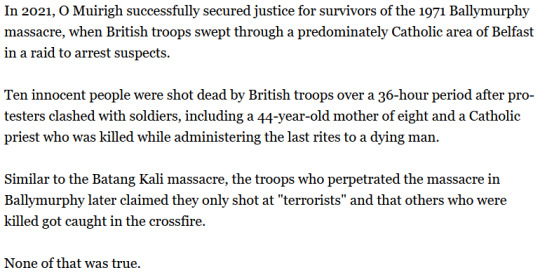
In my opinion, I think these incidents is an eerie parallel to what the Israeli forces is currently doing to the people of Palestine - killing them and then justifying it by saying they were Hamas or hiding Hamas. Or committing crimes and then labeling the victims as Hamas to justify it.
None of this happens in a vacuum. It is all interconnected.

I don't think people understand the long lasting multi-generational impact this kind of horrific acts have on victims and their families. This is an excerpt from the Batang Kali article that describes that:

Colonization impacts people for generations. On a personal level, my grandparents and others in their generation were all impacted by the British colonization and Japanese occupation of Malaya.
Our grandparents were once young people living in occupation. They were young girls hiding from the military to avoid becoming comfort women. They were young boys who were made to do forced labour by the occupiers. Young people who fought and rallied for our freedoms today. They survived for our freedom.
History is already repeating itself in Palestine. Justice for Palestinians does not stop at a ceasefire - just as it did not stop at the end of World War II or after Malaysian and Irish independence. But we have to start somewhere.
And to any Palestinian reading this, in some weird way, I hope that this may bring you hope. These atrocities happened over and over again throughout history and yet, here we are - our people survived. I am here and you are here. Isn't that beautiful? I hope you know that you are not alone in this fight. Its not pretty and its not immediate, but justice will prevail and Palestine will be free in our lifetime.
Ceasefire now.
You can read about the Al Jazeera article about the Batang Kali massacre here:
#irish history#al jazeera#malaysian history#malaysia#batang kali#southeast asia#ireland#belfast#Ballymurphy#palestine#free palestine#west bank#free west bank#gaza#free gaza#colonization#british colonialism#israel#settler violence#great britain#settler terrorism#genocide#image id in alt text#history
10 notes
·
View notes
Text
I don’t care how old those soldiers are, they’re murderers. They knowingly killed unarmed civilians and their officers lied about it and smeared the reputations of the dead. It was because they got away with it at Ballymurphy they knew they could get away with in Derry.
They have to face justice for what they did.
#ballymurphy#ballymurphy massacre#belfast#northern ireland#ireland#irish history#history#british army#the troubles#british history#uk politics#politics#irish politics
1 note
·
View note
Text
Ballymurphy è come uscito da un copione che suona familiare
Ballymurphy è come uscito da un copione che suona familiare
Editoriale di Gerry Adams pubblicato da Belfast Media, a pochi giorni dall’esito dell’inchiesta sul massacro di Ballymurphy nel 1971
Ero nella cappella del Corpus Christi a Springhill la scorsa settimana quando il medico legale, Siobhan Keegan, ha impiegato quasi tre ore per leggere il suo giudizio al termine dell’inchiesta sul massacro di Ballymurphy.
Intorno a me sedevano alcuni dei parenti,…
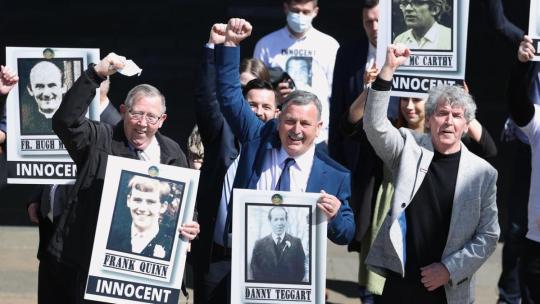
View On WordPress
#ballymurphy massacre#belfast media#bloody sunday#Boris Johnson#british army#collusione#featured#gerry adams#gruppi paramilitari lealisti#irlanda del nord#massacro di Ballymurphy#Rapporto Saville#reggimento paracadutisti del british army#springhill massacre#Troubles
0 notes
Text
#OTD in 1971 – 9-11 | During the internment round-up operation in west Belfast, the Parachute Regiment killed 11 unarmed civilians in what became known as the Ballymurphy massacre.
On 9th of August 1971, Interment Without Trial was introduced by the British Government in the North of Ireland. This policy was implemented by the British Army at 4am on that particular summer morning. The British Army directed the campaign against the predominately Catholic community with the stated aim to “shock and stun the civilian population”.
Between 9th and 11th of August 1971, over 600…
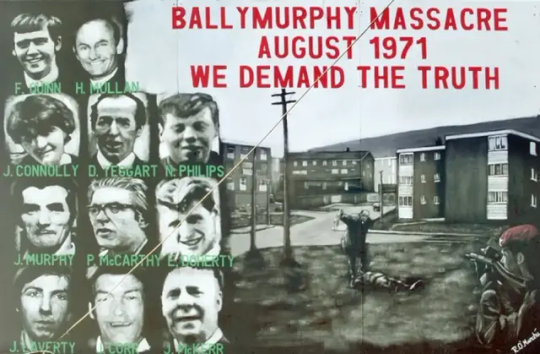
View On WordPress
#Truth Justice#Ballymurphy Massacre#British Army&039;s Parachute Regiment#British paratroopers#Daniel Teggart#Edward Doherty#England#Hugh Mullan#Irish History#Joan Connolly#John Laverty#John McKerr#Joseph Murphy#Noel Phillips#Paddy McCarthy#West Belfast
11 notes
·
View notes
Text
IF YOU HAVE THE CHANCE, PLEASE READ!
Sources are in the notes! Please read those articles as I am not a journalist and simply summarising the info from them.
On Wednesday (15th of July 2021) the UK Government announced a statute of limitations on all possible Troubles-era prosecutions before 1998. Essentially, this means it will be impossible for the victims of the conflict in Northern Ireland to receive justice.
The Troubles (1960s to 1998) was a complex period of history in Northern Ireland, where over 3,500 people were killed. Over 50% of the deaths were civillians caught up in the conflict.
While Boris Johnson claims the amnesty will allow the people of Northern Ireland to “move forward”, in reality it will allow terrorists and war criminals to escape justice. It protects all sides of the conflict, from republican paramilitaries to loyalist paramilitaries to UK security forces. The latter is estimated to be responsible for 10% of the deaths during the period. The statute of limitations would allow the UK to hide its war crimes, such as the Ballymurphy Massacre and Bloody Sunday.
This issue is incredibly complicated, but simply put the actions of the government are a slap in the face the victims’ families. It is not a matter of unionist or nationalist, this is an issue of the UK continuing to not care about the North and the victims of the conflict.
Please, please, please, read the articles in the notes and call out the British Government for this injustice.
#Northern Ireland#Northern Irish#northern irish politics#UK#uk politics#politics#the troubles#signal boost
43 notes
·
View notes
Text
Call to Action: Protest Against the Tory Bill of Shame
https://tftcampaign.com/call-to-action-protest-against-the-tory-bill-of-shame/

View On WordPress
#Ballymurphy Massacre#Bloody Sunday#breach of basic human rights#British Secret Service#MI5#Never Trust A Tory#NI Secretary of State Brandon Lewis#Tory Lies
0 notes
Photo

1 Para was responsible for both the Ballymurphy Massacre (‘71) and the Bloody Sunday Massacre (‘72) only five months apart(via)
16 notes
·
View notes
Video
youtube
Bloody Sunday, or the Bogside Massacre, was a massacre on 30 January 1972 in the Bogside area of Derry, Northern Ireland, when British soldiers shot 26 unarmed civilians during a protest march against internment without trial. Fourteen people died: thirteen were killed outright, while the death of another man four months later was attributed to his injuries. Many of the victims were shot while fleeing from the soldiers, and some were shot while trying to help the wounded. Other protesters were injured by shrapnel, rubber bullets, or batons, and two were run down by British Army vehicles.All of those shot were Catholics. The march had been organised by the Northern Ireland Civil Rights Association (NICRA). The soldiers were from the 1st Battalion, Parachute Regiment ("1 Para"), the same battalion implicated in the Ballymurphy massacre several months prior.
[x]
5 notes
·
View notes
Text
The Troubles, Pt 2
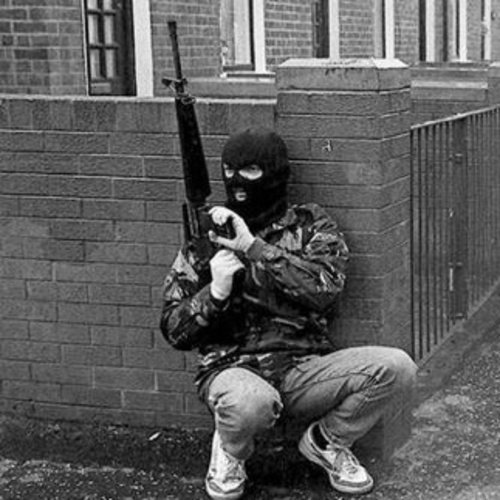
1972
2 January: An anti-internment rally is held in Belfast, North Ireland
3 January: The Irish Republican Army (IRA) explodes a bomb in Callender Street, Belfast, injuring over 60 people.
17 January: Seven men who were held as internees escape from the prison ship HMS Maidstone in Belfast Lough.
21 January: Prime Minister of Northern Ireland Brian Faulkner bans all parades and marches in Northern Ireland until the end of the year.
27 January: Two Royal Ulster Constabulary officers shot dead by IRA in an attack on their patrol car in the Creggan Road, Derry; The British Army and the Irish Republican Army engage in gun battles near County Armagh; British troops fire over 1,000 rounds of ammunition.
28 January: The Northern Ireland Civil Rights Association place "special emphasis on the necessity for a peaceful incident-free day" at the next march on 30 January in an effort to avoid violence.
30 January: Bloody Sunday: 27 unarmed civilians are shot (14 are killed) by the British Army during a civil rights march in Derry, Northern Ireland; this is the highest death toll from a single shooting incident during 'the Troubles.’
31 January: British Home Secretary Reginald Maudling to House of Commons on 'Bloody Sunday', "The Army returned the fire directed at them with aimed shots and inflicted a number of casualties on those who were attacking them with firearms and with bombs.”
1 February: British Prime Minister Edward Heath announces the appointment of Lord Chief Justice Lord Widgery to undertake an inquiry into the 13 deaths on 'Bloody Sunday; The Ministry of Defence also issues a detailed account of the British Army's version of events during 'Bloody Sunday.'
2 February: Angry demonstrators burn the British Embassy in Dublin to the ground in protest at the shooting dead of 13 people on 'bloody sunday'
5 February: Two IRA members are killed when a bomb they were planting exploded prematurely.
6 February: A Civil Rights march held in Newry, County Down; very large turn-out with many people attending to protest at the killings in Derry the previous Sunday.
10 February: BBC bans "Give Ireland Back to the Irish" by Wings; two British soldiers are killed in a land mine attack near Cullyhanna, County Armagh; an IRA member is shot dead during an exchange of gunfire with RUC officers.
14 February: Lord Widgery arrives in Coleraine, where the 'Bloody Sunday' (30 January 1972) Tribunal was to be based, and holds a preliminary hearing.
22 Febuary: The Official IRA bombs Aldershot military barracks, the headquarters of the British Parachute Regiment, killing seven people; thought to be in retaliation for Bloody Sunday.
25 February: Attempted assassination of Irish Minister of State for Home Affairs John Taylor who is shot a number of times (the Official Irish Republican Army later claimed responsibility)
1 March: Two Catholic teenagers shot dead by the Royal Ulster Constabulary while 'joy riding' in a stolen car in Belfast.
4 March: Abercorn Restaurant bombing: a bomb explodes in a crowded restaurant in Belfast, killing two civilians and wounding 130.
9 March: Four members of the Irish Republican Army (IRA) die in a premature explosion at a house in Clonard Street, Lower Falls, Belfast.
14 March: Two IRA members shot dead by British soldiers in the Bogside area of Derry.
15 March: Two British soldiers killed when attempting to defuse a bomb in Belfast; an RUC officer iskilled in an IRA attack in Coalisland, County Tyrone.
18 March: Ulster Vanguard hold a rally of 60,000 people in Belfast; William Craig tells the crowd: "if and when the politicians fail us, it may be our job to liquidate the enemy.”
20 March: Donegall Street bombing: the Provisional Irish Republican Army detonate its first car bomb on Donegall Street in Belfast; four civilians, two RUC officers and a UDR soldier killed while 148 people were wounded.
24 March: Great Britain imposes direct rule over Northern Ireland
27 March: Ulster Vanguard organise industrial strike against the imposition of direct rule on Northern Ireland by Westminster
30 March: Northern Ireland's Government and Parliament dissolved by the British Government and 'direct rule' from Westminster is introduced.
6 April: The Scarman Tribunal Report, an inquiry into the causes of violence during the summer of 1969 in N Ireland, is published, finding that the Royal Ulster Constabulary had been seriously at fault.
7 April: Three members of the Irish Republican Army (IRA) die in a premature bomb explosion in Belfast
10 April: Two British soldiers are killed in a bomb attack in Derry.
14 April: The Provisional Irish Republican Army explodes twenty-four bombs in towns and cities across Northern Ireland.
15 April: A member of the Official Irish Republican Army is shot dead by British soldiers at Joy Street in the Markets area of Belfast close to his home; a member of the British Army is shot dead by the Official IRA in the Divis area of Belfast.< April: Two British soldiers are shot dead by the Official Irish Republican Army (OIRA) in separate incidents in Derry.
18 April: The Widgery Report on 'Bloody Sunday' in Northern Ireland is published, causing outrage among the people of Derry who call it the "Widgery Whitewash.”
19 April: British Prime Minister Edward Heath confirms that a plan to conduct an arrest operation, in the event of a riot during the march on 30 January 1972, was known to British government Ministers in advance.
22 April: An 11-year-old boy killed by a rubber bullet fired by the British Army in Belfast; he was the first to die from a rubber bullet impact.
22 April: The Sunday Times Insight Team publish their account of the events of 'Bloody Sunday.’
10 May: An Irish Republican Army bomb starts a fire that destroys the Belfast Co-operative store.
13 May: Battle at Springmartin: following a loyalist car bombing of a Catholic-owned pub in the Ballymurphy area of Belfast, clashes erupt between PIRA, UVF and British Army.

14 May: 13 year old Catholic girl is shot dead by Loyalist paramilitaries in Ballymurphy, Belfast.
17 May: The Irish Republican Army (IRA) fires on workers leaving the Mackies engineering works in west Belfast (Although the factory was sited in a Catholic area it had an almost entirely Protestant workforce.
21 May: The Official Irish Republican Army (OIRA) kidnaps and shoots dead William Best (19), a soldier in the Royal Irish Rangers stationed in Germany whilst on leave at home.
22 May: Over 400 women in Derry attack the offices of Official Sinn Féin in Derry, North Ireland, following the shooting of William Best by the Official Irish Republican Army.
24 May: Official Irish Republican Army (OIRA) kidnaps and shoots dead William Best (19), a soldier in the Royal Irish Rangers stationed in Germany whilst on leave at home.
26 May: The Irish Republican Army (IRA) plant a bomb in Oxford Street, Belfast, killing a 64 year old woman.
28 May: Four Provisional Irish Republican Army volunteers and four civilians killed when a bomb they were preparing exploded prematurely at a house in Belfast.
29 May: The Official IRA announce a ceasefire.
2 June: British soldiers die in an IRA land mine attack near Rosslea, County Fermanagh.
11 June: Gun battle between Loyalist and Republican paramilitaries break out in the Oldpark area of Belfast.
13 June: The Irish Republican Army invites British Secretary of State for Northern Ireland Willie Whitelaw to 'Free Derry'; Whitelaw rejects offer and reaffirms his policy to not "let part of the United Kingdom ... default from the rule of law.”
14 June: Members of the NI Social Democratic and Labour Party hold a meeting with representatives of the Irish Republican Army in Derry; the IRA representatives outline their conditions for talks with the British Government.
15 June: The Social Democratic and Labour Party meet Secretary of State for Northern Ireland W Whitelaw, to present the IRA's conditions for a meeting.
18 June: 3 members of the British Army are killed by an Irish Republican Army (IRA) bomb in a derelict house near Lurgan, County Down.
19 June: A Catholic civilian is shot dead by the Provisional Irish Republican Army in the Cracked Cup Social Club, Belfast; Secretary of State for Northern Ireland William Whitelaw concedes 'special category' status, or 'political status' for paramilitary prisoners in Northern Ireland.
20 June: Secret Meeting Between IRA and British Officials held.
22 June: The Irish Republican Army announce that it would call a ceasefire from 26 June 1972 provided that there is a "reciprocal response" from the security forces.
24 June: The Irish Republican Army (IRA) kill 3 British Army soldiers in a land mine attack near Dungiven, County Derry.
26 June: IRA proclaims resistant in North-Ireland; The Provisional Irish Republican Army (IRA) begin a "bi-lateral truce" as at midnight; The Irish Republican Army (IRA) kill two British Army soldiers in separate attacks during the day.
30 June: Ulster Defence Association (UDA) begin to organise its own 'no-go' areas (this is a response to the continuation of Republican 'no-go' areas and fears about concessions to the IRA).
2 July: Two Catholic civilians are shot and killed in Belfast by Loyalist paramilitaries, probably the Ulster Defence Association (UDA)
3 July: The Ulster Defence Association and the British Army come into conflict about a 'no-go' area at Ainsworth Avenue, Belfast
4 July: The Royal Ulster Constabulary forward a file about the killings on 'Bloody Sunday' (30 January 1972) to the Director of Public Prosecutions for Northern Ireland
5 July: Two Protestant brothers are found shot dead outside of Belfast (speculation that they were killed by Loyalists because they had Catholic girlfriends).
7 July: Secret Talks Between IRA and British Government: Gerry Adams is part of a delegation to London for talks with the British Government; 7 people are killed in separate incidents across Northern Ireland.
9 July: Springhill Massacre: British snipers shoot dead five Catholic civilians and wounded two others in Springhill, Belfast; The ceasefire between the Provisional IRA and the British Army comes to an end.
13 July: A series of gun-battles and shootings erupt across Belfast between the Provisional Irish Republican Army and British Army soldiers.
18 July: The 100th British soldier to die in the Northern Ireland "troubles" is shot by a sniper in Belfast; Leader of the British Labour Party Harold Wilson holds meeting with representatives of the Irish Republican Army.
21 July: Bloody Friday: within the space of seventy-five minutes, the Provisional Irish Republican Army explode twenty-two bombs in Belfast; six civilians, two British Army soldiers and one UDA volunteer were killed, 130 injured.
22 July: 2 Catholics are abducted, beaten, and shot dead in a Loyalist area of Belfast.
31 July: Operation Motorman: the British Army use 12,000 soldiers supported by tanks and bulldozers to re-take the "no-go areas" controlled by the Provisional Irish Republican Army; Claudy bombing: nine civilians were killed when three car bombs exploded in County Londonderry, North Ireland; no group has since claimed responsibility.
9 August: There is widespread and severe rioting in Nationalist areas of Northern Ireland on the anniversary of the introduction of Internment.
11 August: Two IRA members are killed when a bomb they were transporting exploded prematurely.
12 August: British soldiers are killed by an IRA booby trap bomb in Belfast.
14 August: A Catholic civilian is shot dead during an IRA attack on a British Army patrol in Belfast.
22 August: IRA bomb explodes prematurely at a customs post at Newry, County Down - 9 people, including three members of the IRA and five Catholic civilians, are killed in the explosion.
23 August: 4 civilians and 1 British soldier are injured in separate overnight shooting incidents in North Ireland.
2 September: The headquarters of the Ulster Unionist Party (UUP) in Belfast is severely damaged by an IRA bomb.
10 September: 3 British soldiers are killed in a land mine attack near Dungannon, County Tyrone.
14 September: 2 people are killed and 1 mortally wounded in a Ulster Volunteer Force bomb attack on the Imperial Hotel, Belfast.
20 September: The Social Democratic and Labour Party issues a document entitled "Towards a New Ireland", proposing that the British and Irish governments should have joint sovereignty over Northern Ireland.

6 October: Taoiseach (Irish Prime Minister) Jack Lynch closes the Sinn Féin office in Dublin.
10 October: 3 members of the Irish Republican Army (IRA) die in a premature explosion in a house in Balkan Street, Lower Falls, Belfast.
14 October: North Irish Loyalist paramilitaries raid Headquarters of the 10 Ulster Defence Regiment in Belfast and steal rifles and ammunition.
16 October: 2 members of the Offical Irish Republican Army are shot dead by the British Army in County Tyrone. Protestant youth members of the Ulster Defence Association, and a UDA member are run over by British Army vehicles during riots in east Belfast.
17 October: The Ulster Defence Association open fire on the British Army in several areas of Belfast.
19 October: The Ulster Defence Association open fire on the British Army in several areas of Belfast.
23 October: Loyalist paramilitaries carry out raid on an Ulster Defence Regiment.
24 October: British soldiers kill 2 Catholic men at a farm at Aughinahinch, near Newtownbbutler, County Fermanagh.
30 October: The Northern Ireland Office issues a discussion document 'The Future of Northern Ireland'; the paper states Britain's commitment to the union as long as the majority of people wish to remain part of the United Kingdom; Loyalist paramilitaries carry out a raid on Royal Ulster Constabulary station in County Derry, and steal 4 British Army Sterling sub-machine Guns.
31 October: 2 Catholic children (6 and 4) playing on the street are killed in a Ulster Freedom Fighters (UFF) car bomb attack on a bar in Ship Street, Belfast.
2 November: Government of the Republic of Ireland introduce a bill to remove the special position of the Catholic Church from the Irish Constitution.
5 November: Vice-President of Sinn Féin Maire Drumm is arrested in the Republic of Ireland.
19 November: Leader of the Irish Republican Army (IRA) Seán MacStiofáin is arrested in Dublin.
20 November: 2 British soldiers are killed in a booby trap bomb in Cullyhanna, County Armagh.
24 November: Taoiseach Jack Lynch meets with British Prime Minister Edward Heath in London to give Irish approval to Attlee's paper stating new arrangements should be 'acceptable to and accepted by the Republic of Ireland'
26 November: Bomb explosion at the Film Centre Cinema, in O’Connell Bridge House in Dublin.
28 November: 2 IRA members are killed in a premature bomb explosion in the Bogside area of Derry.
1 December: 2 people killed and 127 injured when 2 car bombs explode in the centre of Dublin, Republic of Ireland
20 December: Five civilians (four Catholics, one Protestant) killed in gun attack on the Top of the Hill Bar in Derry, North Ireland.
28 December: 2 people are killed in a Loyalist bomb attack on the village of Belturbet, County Cavan, Republic of Ireland.
29 December: President of Sinn Féin Ruairi O Bradaigh is arrested and held under new legislation in Republic of Ireland.


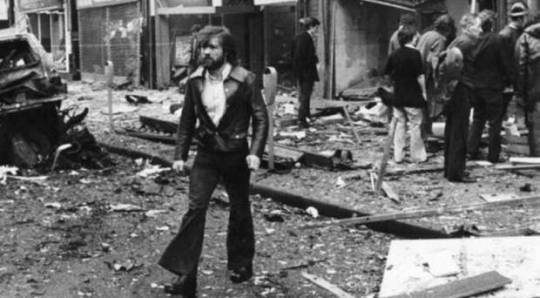
#ulster#northern ireland#irish republican army#sinn fein#the troubles#belfast#united kingdom#edward heath#derry
129 notes
·
View notes